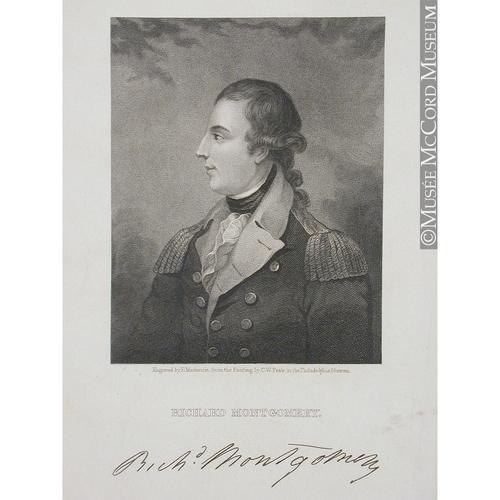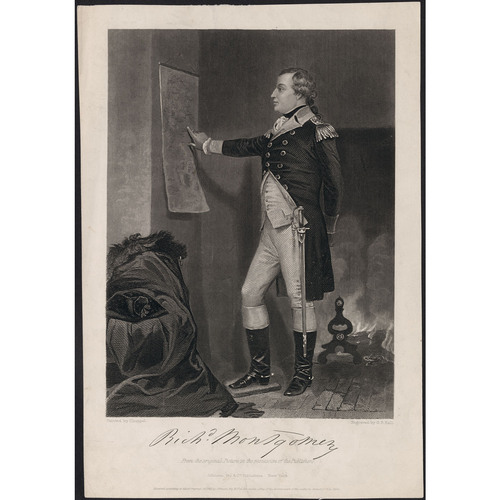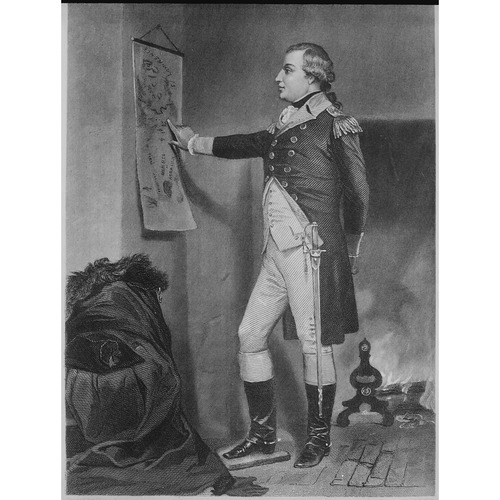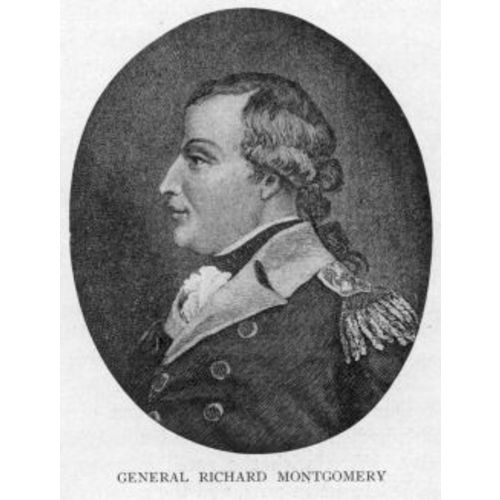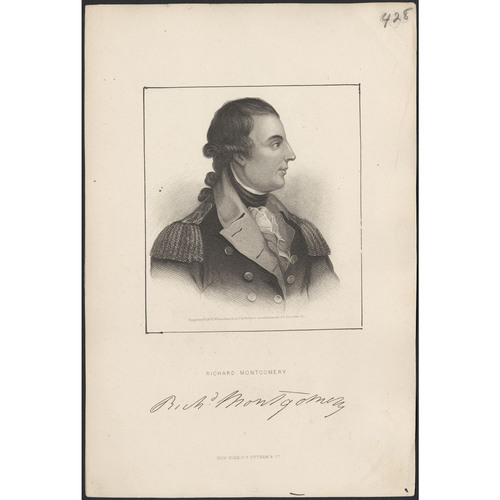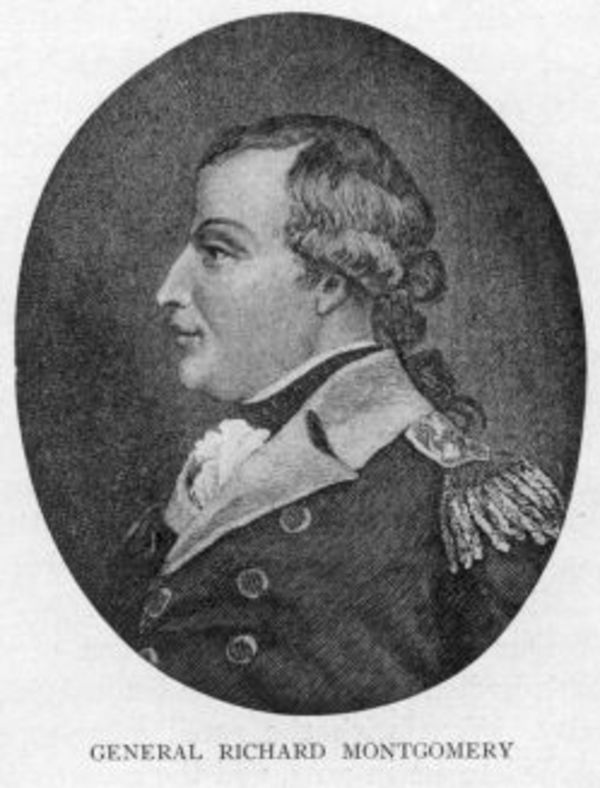
Source: Courtesy of Wikimedia Commons
MONTGOMERY, RICHARD, army officer; b. 2 Dec. 1736 near Swords (Republic of Ireland), third son of Thomas Montgomery, member of the Irish parliament for Lifford, and Mary Franklyn (Franklin); m. 24 July 1773 Janet Livingston; d. 31 Dec. 1775 at Quebec.
Richard Montgomery was born into a respectable family of Irish gentry and after his initial schooling was sent to Trinity College, Dublin, in 1754. He did not take a degree, however, but instead on 21 Sept. 1756 entered the army as an ensign in the 17th Foot. His regiment saw much active service overseas during the Seven Years’ War. In 1759 it was with Amherst on Lake Champlain and in 1760 with William Haviland in the operations leading to the conquest of Canada, and in 1762 it participated in the attacks on Martinique and Havana, Cuba. Montgomery rose steadily in rank in these years. In July 1758 he became a lieutenant, in May 1760 the regimental adjutant, and in May 1762 a captain. But soldiering during the period of peace after 1763 proved frustrating because of his inability to advance, and in April 1772 he sold his commission and emigrated to America. There he purchased a farm near New York City where he indulged his newly acquired “violent passion” for farming. His marriage the following year to a member of the powerful and strongly pro-colonial Livingston family, was, in view of his background, unusual, but he was a friend of liberal politicians in England and had formed a sympathy for the American cause. The couple settled on the wife’s estate near Rhinebeck (N.Y.).
The armed clashes between British troops and colonists at Lexington and Concord (Mass.) in April 1775 touched off hostilities elsewhere, and in May the frontier forts of Crown Point and Ticonderoga (N.Y.) were seized by Ethan Allen and Benedict Arnold*. Allen and Arnold followed up their successes by raiding into Canada as far as Saint-Jean (Quo.), and their relatively good luck convinced them that an invasion of the province would be successful. The Continental Congress had been concerned for some months about the potential danger to the northern colonies posed by British troops, Canadians, and Indians operating from Canada, but apart from several addresses to the Canadian population urging solidarity with the other colonies it had hitherto given Canada little attention, and on 1 June had in fact forbidden any invasion of Canada. Now, however, with Allen’s and Arnold’s reports of weak British defences and their belief that the Canadians were inclined to remain neutral if the Americans invaded, and with much the same information coming from American sympathizers and emissaries in Canada, Congress reversed its policy. On 27 June it ordered Major-General Philip John Schuyler, commanding in New York, to assemble an army and capture Île aux Noix on the Rivière Richelieu, Saint-Jean, and Montreal and defeat the British forces in Canada “if practicable and . . . not . . . disagreeable to the Canadians.” The Canadians and Indians in Canada were to be urged to remain neutral and even to join the colonial union, and emissaries were dispatched to attain these ends. During July and August some 2,000 men began to gather in upper New York. The second in command of the expedition was Montgomery. His support of the American cause had led to his election to the New York provincial congress earlier in 1775, and on 22 June he was appointed a brigadier-general in the newly formed Continental Army, doubtless because of his previous military experience. Montgomery was, however, at first reluctant to accept the rank. He was unwilling to leave his wife and the comforts of civilian life or to take arms against his countrymen, but he at length consented, in part because he believed that “the will of an oppressed people . . . must be respected.”
Governor Guy Carleton* of Quebec was meanwhile experiencing considerable difficulty in raising a defensive force. When he had called up the militia in June as a response to the American raids, he was faced with considerable resistance to militia service and a widespread feeling for neutrality among the population. Although the militia had finally been embodied in August, Carleton was convinced that it would be “unadvisable to attempt assembling any Number of them, except it becomes absolutely necessary . . . .” With only about 800 British regulars available to garrison the entire province, the government position was weak.
There were several reasons for the population’s reaction. Since late 1774 letters, addresses, pamphlets, and reports had been entering Canada from the southern colonies urging neutrality in any conflict, and they had had a considerable effect, especially since the terms of the Quebec Act of 1774 had been misrepresented in the province. Such propaganda had been spread mainly by British and American merchants such as Thomas Walker, who had been angered by the British government’s refusal to give them English laws and a house of assembly in the Quebec Act and had subsequently become sympathetic to the American cause. These merchants were allowed to disseminate their views throughout the summer of 1775, and even after the beginning of hostilities. Moreover, while the seigneurs, clergy, and bourgeoisie were almost uniformly loyal to the British thanks to the religious and legal guarantees contained in the Quebec Act, the bulk of the population was still alienated enough by language, religion, and the memory of the conquest to be receptive to American requests for neutrality. During the raising of the militia, Carleton had erred in placing too much responsibility for its embodiment with the seigneurs. Not only had they lost influence after the conquest owing to economic factors and a rise of independence among their tenants, but they had displayed favouritism in selecting militia officers as well as a generally haughty attitude and had thus succeeded in alienating otherwise moderate habitants. Nor did the church’s threat of ecclesiastical punishment for recalcitrant militiamen have much effect. One final factor was the weak British garrison; the population could reason that since the British seemed unable to defend them, they had little reason to antagonize the Americans. Carleton had small prospect of reinforcements from Gage in Boston, moreover; as the governor himself expressed it, “every Individual seemed to feel our present impotent situation.” There were, it is true, undercurrents of support among the Canadians which might result in some help for the government, but that aid would be determined very much by developing circumstances.
Early in September Schuyler’s troops established themselves on Canadian soil at Île aux Noix. Schuyler proclaimed that he would “receive in the most favourable manner every inhabitant of Canada and every friend to liberty,” would protect their possessions, and would ensure religious freedom. From the beginning, numbers of Canadians came forward to offer their services. The Richelieu parishes were particularly forward, having been especially receptive to American propaganda, and James Livingston, a former Sorel grain merchant and a relation of Montgomery, was appointed to command the volunteers. Many more took no active part but furnished provisions and transportation to the American troops. Payment for these services had to be in cash, however; Canadians had bitter memories of paper money from the French régime.
The first objective of the invaders was Fort Saint-Jean, where large amounts of military stores were kept. It was also the garrison for about 500 British regulars under Major Charles Preston, who were aided by a group of Canadian volunteers under François-Marie Picoté de Belestre. Because Schuyler had “not enjoyed a moment’s health” for some time, he handed over command to Montgomery on 16 September and went home. The latter was hampered in the siege by bad weather, weak artillery, and insufficient supplies, and by the poor discipline of his disease-ridden men; he nearly resigned in frustration. Until the end of September only a blockade and an intermittent bombardment were possible, “which never annoyed the Enemy in the least.” In Montreal, Carleton had still not been able to raise an effective militia force, but late in September the situation suddenly changed. On the 25th Ethan Allen and a mixed force of Canadians and Americans, attempting to capture Montreal by surprise, were defeated by a hastily assembled group of regulars, militia, and Indians under Major John Campbell. The effect of the victory was so great that, according to the lawyer Simon Sanguinet, some 1,200 militiamen came into Montreal within a week to offer their services, including 300 from rebel-threatened Varennes, who arrived “with the best will in the world.” Carleton was now able to muster a force of 2,000 men, mostly militia, and it was hoped that he would soon counter-attack.
But for three weeks the governor made no move, in part because he distrusted the militia for their earlier reluctance and their leaders for their loss of influence, and in part because he wished to avoid more fighting with the Americans in hopes of a reconciliation. Discouraged and bored, militiamen began to leave by permission or to desert to harvest their crops and protect their homes and families from possible reprisals. Then on 18 October, Fort Chambly surrendered to an American force largely made up of Canadians. Quantities of ammunition and stores were thus available for the besiegers of Saint-Jean. Elsewhere in the province Canadians remained unwilling to serve a cause they now saw in jeopardy. Adam Mabane was confronted by 250 men armed with sticks when he tried to raise the militia on the Île d’Orléans, and it was reported that only 15 men came to support the government from the parishes below Quebec. Farther west, Louis-Joseph Godefroy de Tonnancour and Jean-Baptiste-Marie Blaise Des Bergères de Rigauville were forcibly prevented by other Canadians at Berthier-en-Haut (Berthierville) and Verchères from joining government forces with the militia they had collected. Upon receipt of this last news, 30 to 40 militiamen began to desert each night in Montreal. It was now obvious that Carleton had to mount a counter-offensive or watch his force disappear, but he did so only on 30 October. Some 1,000 militia, Indians, and regulars were to land at Longueuil and march to relieve Saint-Jean, but the Americans prevented their landing. The fort’s defenders were growing short of provisions, Montgomery had new batteries which were destroying the buildings, and ammunition was low. After hearing of the relief force’s failure, the garrison surrendered on 3 November. Some 2,000 Americans and several hundred Canadians were now opposed around Montreal to about 150 British regulars and a rapidly disappearing Canadian militia. Carleton had little choice but to evacuate Montreal on the 11th with his regulars and sail for Quebec. The fleet was halted at Sorel by the threat of American batteries, and though Carleton and his aide-decamp Charles-Louis Tarieu* de Lanaudière managed to escape with the aid of Jean-Baptiste Bouchette*, the rest of the force had to surrender on 19 November, thus limiting effective government resistance to the city of Quebec.
Montgomery had landed troops on Île des Sœurs near Montreal on 11 November, and the next day he received a committee of Montreal citizens including James McGill*, Jean-Louis Besnard, dit Carignant, and Pierre-Méru Panet*. Although rejecting their request for acceptance of a formal capitulation, the American general promised not to force loyalists to oppose the government actively, to guarantee the “peaceable enjoyment of property,” and to allow the “free exercise . . . of religion.” Montreal was occupied on the 13th, and Valentin Jautard presented an address of welcome from some pro-American inhabitants. Shortly thereafter Montgomery received a delegation from Trois-Rivières which included Jean-Baptiste Badeaux and he promised good treatment for their town. But although British resistance in almost all the province had collapsed and the Canadians were generally observing a benevolent neutrality towards the Americans, Montgomery wished to secure their active support. Believing that he would not obtain it unless Quebec was taken, he started out on this objective with 300 men on 28 November, posting a garrison of 500 under Brigadier-General David Wooster in Montreal, Saint-Jean, and Chambly.
At Quebec meanwhile, Lieutenant Governor Hector Theophilus Cramahé was trying to defend the city, but he too was hampered by pro-American sympathies among the population. Early in November matters had worsened when it was learned that a second American army was close to Quebec. This force, commanded by Benedict Arnold, had left Cambridge (Mass.) in September with orders from George Washington himself to attempt to surprise Quebec or at least join Montgomery. The march, up the Kennebec River (Maine) and thence over the height of land to the Rivière Chaudière, had been a gruelling one through a trackless wilderness, and only some 600 of the original 1,100 reached Pointe-Lévy (Lauzon, Lévis) on 9 November. The Americans crossed to the Plains of Abraham on the night of the 13th, but six days later retreated upriver to Pointe-aux-Trembles (Neuville) to wait for Montgomery. Although local inhabitants had received the starving rebels with provisions and transportation, the Americans were nevertheless “almost naked,” low in ammunition, and apprehensive of a British sortie. Montgomery arrived on 3 December and took command; two days later the siege of Quebec began. With reinforcements of local Canadians [see Maurice Desdevens de Glandon] and those from Livingston’s unit (which had been made an American regiment), there were about 1,000 Americans and 200 Canadians, scattered in groups across the Plains down to the Rivière Saint-Charles. The local population supplied them with wood and provisions (although again for cash) and morale was high, although stores were low. Within Quebec, morale had improved with the arrival of Lieutenant-Colonel Allan Maclean and 100 of his newly raised Royal Highland Emigrants on 11 November and of Carleton himself on the 19th. The governor immediately expelled all those refusing to serve in the militia, and he made preparations for a vigorous defence; guns were mounted on the walls and barricades and blockhouses constructed. The garrison of 1,800 men, composed of British and Canadian militia, regulars, seamen, and some artificers, had provisions for themselves and the 3,200 inhabitants for eight months, and abundant military stores.
Montgomery soon discovered the British artillery was considerably superior to his own, but he had never intended to bombard Quebec into surrender. The urgings of his superiors in Boston and Philadelphia, who badly needed the military stores in Quebec, smallpox among his men, the imminent expiry of many enlistments, and the small likelihood of immediate reinforcement all combined to convince him he should attack rather than blockade the city until spring. It was finally decided to mount a concentfic attack on Lower Town, relying on confusion and collaborators to force Carleton to abandon the strongly fortified Upper Town and give battle. The attack was ordered for the first dark night.
That condition was fulfilled on the night of 30–31 December. At about five o’clock in the morning, in a raging snowstorm, Montgomery and 200 men travelled along the river bank from Cap Diamant towards the district of Près-de-Ville. Simultaneously, Arnold’s 600 men were advancing from the suburb of Saint-Roch towards Rue Sault-au-Matelot and an eventual junction with Montgomery in Lower Town. The defenders had been warned by deserters and, alerted by Captain Malcolm Fraser*, they turned out rapidly. At Près-de-Ville were British seamen under Captain Adam Barnsfare and Canadian militia under François Chabot and Louis-Alexandre Picard, accompanied by John Coffin*. Themselves unseen in the blizzard, they watched until Montgomery and some others moved in front of the main body, then delivered a volley which cut them down. The other Americans retreated hastily. On the other front, Arnold was wounded and evacuated, but his men pressed on to overrun a barricade at Sault-au-Matelot and take some prisoners. They were then halted by stiff resistance from regulars and militia under Henry Caldwell*, in which John Nairne* and François Dambourgès were prominent. Informed of Montgomery’s repulse, Carleton transferred troops and surrounded Arnold’s men, who capitulated at about eight o’clock. The boast of a British officer that the garrison had won “as compleat a little victory as ever was gained” was justified. Between 60 and 100 rebels had been killed or wounded and another 400 or so captured for the loss of not quite 20 British and Canadians.
Although the remaining Americans, now commanded by Arnold, were apprehensive of a British counter-attack, Carleton was dubious of the morale of his garrison and cautiously remained in Quebec for the remainder of the winter. Rebel strength remained low despite reinforcements, thanks to continuing smallpox epidemics and expiring periods of enlistment. They could therefore only maintain a blockade with an intermittent artillery bombardment, which in four months only “killed a boy, a cow, wounded a sailor and a turkey, and frightened an old woman into fits.” On 1 April 1776 a discouraged Arnold was replaced by Wooster and went to command at Montreal; one month later Wooster was himself superseded by Major-General John Thomas. The latter could muster 1,900 men, but only 1,000 were fit for duty, and of those 300 were clamouring for discharge since their periods of enlistment had ended.
In the mean time, Canadian attitudes had been changing. An undercurrent of loyalism had persisted in many areas, and in March a group of Canadians had even attempted to attack the American camp at Pointe-Lévy [see Charles-François Bailly de Messein; Michel Blais]. If the majority did not choose such overt action, they nevertheless were becoming more anti-American, if not pro-British. The clergy, strongly loyal, had a noticeable influence, as did the upper classes. Moreover, the continued low strength of the American forces was leading the inhabitants to the same conclusions as they had previously drawn with the British. Nor were Canadians any more eager to fight for the rebels: Moses Hazen* complained that recruiting for the regiment he was raising for Congress went poorly and that the men were unsuitable, deserting at the first opportunity. The greatest single factor for change was the Americans’ growing use of paper money and promissory notes in payment for goods and services, which seemed to indicate to the population the financial bankruptcy of the American cause. And considering that the Americans commandeered supplies frequently as well, the increasing alienation of the population is understandable. Montreal in particular had cause to regret the invasion. Wooster had embarked on a series of arbitrary and ill-judged actions over the winter of 1775–76 which broke most of Montgomery’s promises. He closed the “Mass Houses” on Christmas eve, attempted to arrest loyalists such as Simon Sanguinet and Georges-Hippolyte Le Comte Dupré, and announced that all who opposed congressional wishes would be arrested as traitors. Not content with these actions, he took Edward William Gray* and René-Ovide Hertel de Rouville hostage to ensure the disarming of three suburbs thought hostile to the Americans, and he arrested Le Comte Dupré and Thomas-Ignace Trottier Dufy Desauniers when they refused to exchange their British militia commissions for American ones. By the spring of 1776 American fortunes had sunk to such a low ebb that Benjamin Franklin, Charles Carroll, and Samuel Chase, who arrived in Montreal in April as commissioners appointed by Congress to undertake the political conversion of the Canadians, soon became discouraged and even counselled abandonment of the country.
But any Canadian support for the British was still mainly covert, and only large British reinforcements could really make the Canadians active in opposition. On 6 May 1776 a small squadron under Charles Douglas arrived off Quebec and landed troops. Carleton sortied the same day. The Americans, caught off guard as they prepared to raise the siege, retreated “in the utmost hurry and confusion,” not stopping until they reached Sorel. Carleton declined to pursue and instead waited for the massive reinforcements of British and German regulars under John Burgoyne approaching from Britain. In mid May 400 Americans were captured at Les Cèdres, west of Montreal, by an ad hoc force of regulars, Indians, and Canadians drawn from the Upper Lakes posts. American troops now controlled only the Montreal-Richelieu valley region, but substantial reinforcements released by the end of the siege of Boston enabled Brigadier-General John Sullivan, now commanding in Canada (Thomas was mortally ill with smallpox and Wooster had been recalled to explain his conduct at Montreal), to concentrate 5,000 men at Sorel by late May. As the first stage in a planned counter-offensive, Sullivan sent Brigadier-General William Thompson and 2,200 men against Trois-Rivières, which was believed to be lightly held. But Thompson’s advance slowed down [see François Guillot, dit Larose], and when the Americans arrived before the town on 8 June they found it held by 7,000 British regulars from Burgoyne’s force. The rebels were soundly defeated with the loss of 200 prisoners, one of whom was Thompson. Thereafter their position in Canada rapidly crumbled. Some 10,000 British and German regulars were pressing hard down the St Lawrence in pursuit, almost 3,000 Americans were ill, and Canadians were now beginning to turn openly against the invaders. By 18 June the forces of Arnold (who narrowly escaped from Montreal) and Sullivan had fallen back to Saint-Jean and two weeks later, closely pursued by the British, they had retreated over the frontier. No further attempt was made during the war to invade Canada, although rumours kept Haldimand worried.
As the Americans retreated, normal life returned to Quebec. Carleton was generally lenient with the inhabitants who had supported the rebels, perhaps because of his prediction before the invasion that Canadians would not aid the government in large numbers. All the same, some punishments were meted out. A commission consisting of Gabriel-Elzéar Taschereau*, François Baby*, and Jenkin Williams* was appointed by the governor to investigate the extent and nature of collaboration in the Quebec region, and between 22 May and 16 July it toured the parishes. The commission found that many parishes had actively supported or encouraged the invaders, that others had been neutral, and that a small number had been sympathetic to the government. Nevertheless, the only reprisals generally taken were the replacement of many militia officers, who had been particularly pro-American, and the billeting of troops on especially stubborn parishes. Although the punishments were mild, complaints arose that they had not been equitably distributed, and after the invasion was over Carleton was much harsher with American sympathizers and imprisoned several. In his efforts to restore order he had the support of the church, which pursued a strict policy towards rebel supporters and backsliders. Bishop Briand decreed that the sacraments would be refused to those American sympathizers who did not atone for their transgression by public penance, but some time elapsed before this order was generally obeyed, and many remained unrepentant.
The invasion of Canada was a minor campaign in what soon became a much wider and more complicated conflict, and it was by and large unnecessary. The Americans had no clear idea of their objectives in invading the country, and when it became obvious that Canada had to be completely occupied and pacified, ‘their rudimentary organization was incapable of sustaining such a full-scale effort. In any case, it was practically inevitable that the British would sooner or later mount a counter-offensive – the loss of Canada would have been a serious blow to their hopes of quickly crushing the rebellion – and that, given their unchallenged naval supremacy, they could concentrate enough troops to reconquer the province. But the invasion would not have succeeded or, if it had, the reconquest would have been more bloody and drawn out than it actually was, had the Canadians inclined strongly to one side or the other. That they chose to maintain a changeable neutrality is indicative of their lack of sympathy with either side and of their realization that a flexible policy of neutrality was the course which could best serve their interests in the fluid and uncertain circumstances of the invasion and spare them the misery which had accompanied the conquest 15 years previously.
On the morning after the American defeat before Quebec in December 1775 the frozen bodies of Montgomery and several companions were discovered beneath a snow-drift. Thomas Ainslie* recorded that those in Quebec who had known the dead American officer (he had been made major-general on 9 December but had never received the news) expressed sincere regrets at his death, and even Carleton apparently grieved for his “deluded friend.” Cramahé had Montgomery’s body “decently interred” at his personal expense; in 1818 it was returned to the United States. Montgomery was also mourned by his compatriots, who considered him a promising and popular officer. Captain Simeon Thayer of Arnold’s force left this description: “a genteel appearing man, tall and slender of make, . . . of an agreeable temper, and a virtuous General.”
[Since Montgomery had such a short career in the revolution, there has been comparatively little written about him. There is a biography by A. L. Todd, entitled Richard Montgomery: rebel of 1775 (New York, 1966), but its superficial research and naive style of writing make it of little value. There are entries in the DAB and DNB. Sources used for biographical material include G.B., WO, Army list, 1756–72; F. B. Heitman, Historical register of officers of the Continental Army during the war of the revolution . . . (Washington, 1893); and T. H. Montgomery, “Ancestry of Gen. Richard Montgomery,” New-York Geneal. and Biographical Record (New York), II (1871), 123–30. s.r.j.s.]
[Thomas Ainslie], “Journal of the most remarkable occurences in the province of Quebec from the appearance of the rebels in September 1775 until their retreat on the sixth of May 1776,” ed. F. C. Würtele, Literary and Hist. Soc. of Quebec, Hist. Docs., 7th ser. (1905), [9]–89. American archives (Clarke and Force), 4th ser., III-VI. [Henry Caldwell], “The invasion of Canada in 1775: letter attributed to Colonel Henry Caldwell,” Literary and Hist. Soc. of Quebec, Hist. Docs., 2nd ser. (1868), 1–19. Can., Dept. of Militia and Defence, General Staff, A history of the organization, development and services of the military and naval forces of Canada, from the peace of Paris in 1763, to the present time . . . (3v., [Ottawa, 1919–20]), I. [Jacob Danford], “Quebec under siege, 1775–1776: the ‘Memorandums’ of Jacob Danford,” ed. J. F. Roche, CHR, L (1969), 68–85. Docs. relating to constitutional history, 1759–91 (Shortt and Doughty; 1907), 450–59. Invasion du Canada (Verreau). “Journal of the most remarkable occurences in Quebec since Arnold appear’d before the town on the 14th November 1775,” Literary and Hist. Soc. of Quebec, Hist. Docs., 7th ser. (1905), 93–154. “Journal of the siege and blockade of Quebec by the American rebels, in autumn 1775 and winter 1776,” Literary and Hist. Soc. of Quebec, Hist. Docs., 4th ser. (1875), [3]–25. “Journal par Messrs Frans Baby, Gab. Taschereau et Jenkin Williams . . . ,” Ægidius Fauteux, édit., ANQ Rapport, 1927–28, 431–99. March to Quebec: journals of the members of Arnold’s expedition, ed. K. L. Roberts (New York, 1938). “Orderly book begun by Captain Anthony Vialar of the British militia . . . ,” ed. F. C. Würtele, Literary and Hist. Soc. of Quebec, Hist. Docs., 7th ser. (1905), 155–265. PAC Report, 1914–15, app.B, 5–25. [Rudolphus Ritzema], “Journal of Col. Rudolphus Ritzema, of the First New York Regiment, August 8, 1775, to March 30, 1776,” Magazine of American History (New York), I (1877), 98–107. “Rôle général de la milice canadienne du Québec . . . ,” Literary and Hist. Soc. of Quebec, Hist. Docs., 8th ser. (1906), 269–307. “State papers,” PAC Report, 1890. Boatner, Encyclopedia of American revolution. The toll of independence: engagements and battle casualties of the American revolution, ed. H. H. Peckham (Chicago, 1974). Allen French, The first year of the American revolution (Cambridge, Mass., 1934). Lanctot, Canada and American revolution. J. H. Smith, Our struggle for the fourteenth colony: Canada and the American revolution (2v., New York, 1907). G. F. G. Stanley, Canada invaded, 1775–1776 (Toronto, 1973).
Cite This Article
Stuart R. J. Sutherland, “MONTGOMERY, RICHARD,” in Dictionary of Canadian Biography, vol. 4, University of Toronto/Université Laval, 2003–, accessed March 30, 2025, https://www.biographi.ca/en/bio/montgomery_richard_4E.html.
The citation above shows the format for footnotes and endnotes according to the Chicago manual of style (16th edition). Information to be used in other citation formats:
| Permalink: | https://www.biographi.ca/en/bio/montgomery_richard_4E.html |
| Author of Article: | Stuart R. J. Sutherland |
| Title of Article: | MONTGOMERY, RICHARD |
| Publication Name: | Dictionary of Canadian Biography, vol. 4 |
| Publisher: | University of Toronto/Université Laval |
| Year of revision: | 1979 |
| Access Date: | March 30, 2025 |


